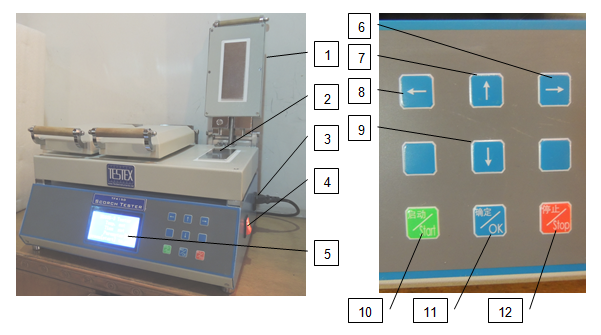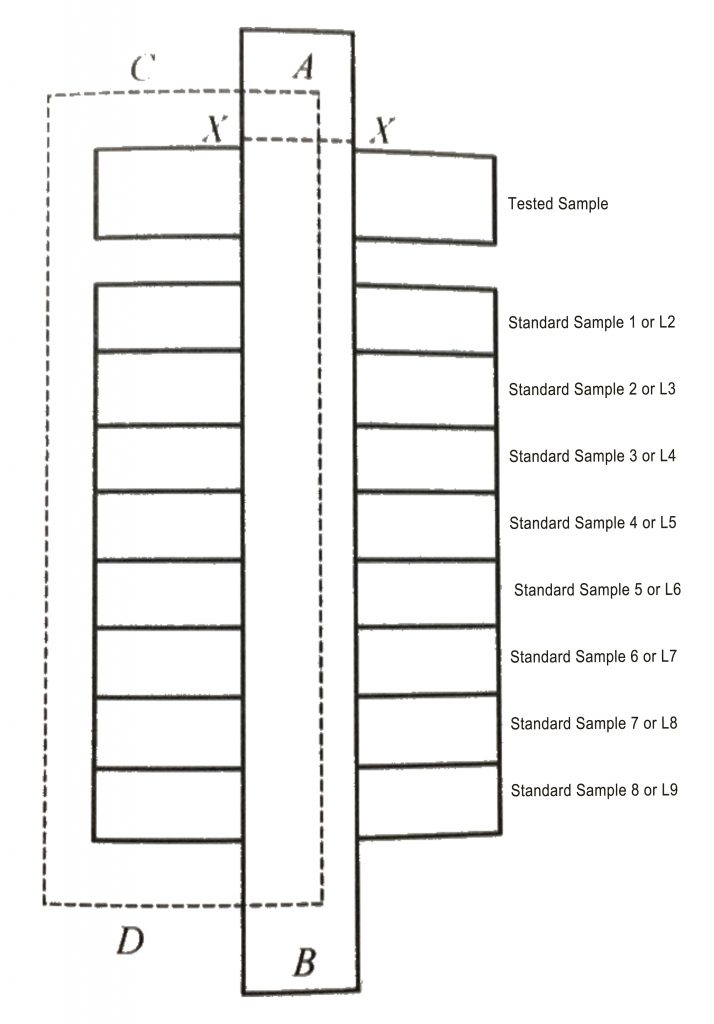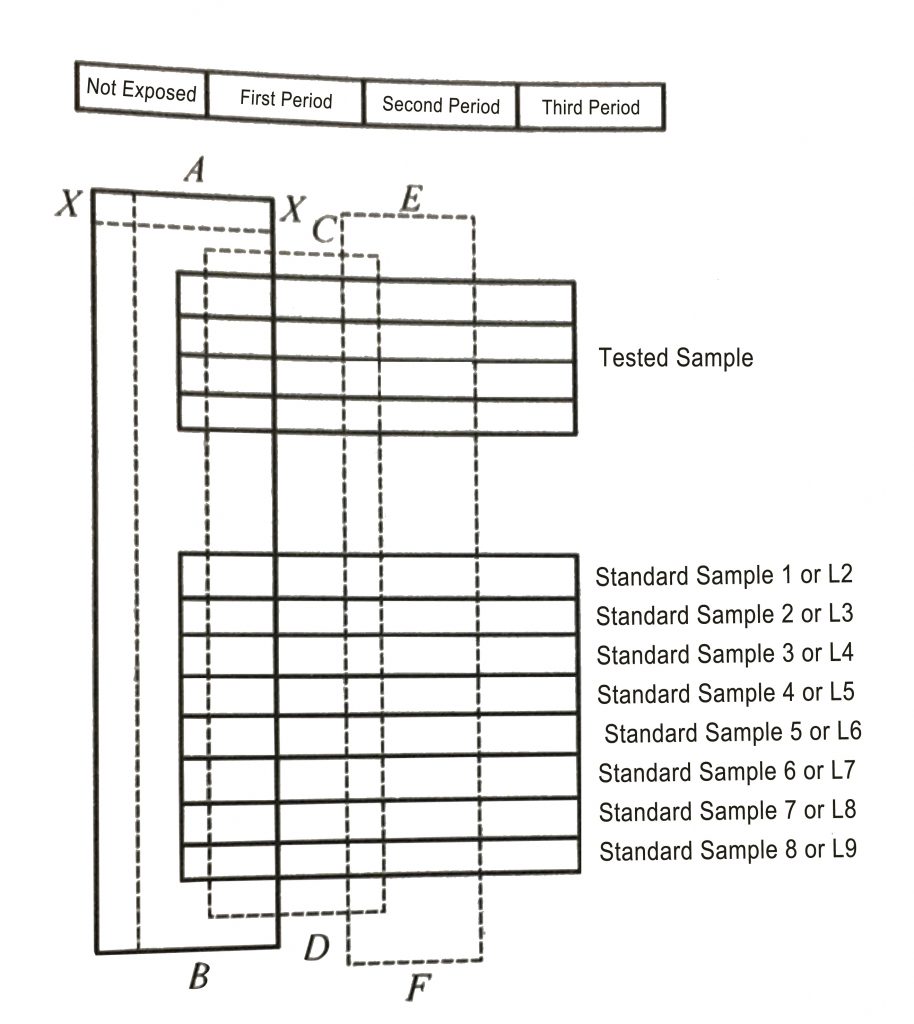The colorfastness property of textiles is a very important parameter from a selling point…
What Do Sublimation Fastness and Lightfastness Really Mean? And How to Test Color fastness to Light and Color Fastness to Sublimation?
Definition and Measurement of Heat Color Fastness
- Heat Color Fastness
Heat color fastness refers to the ability to keep original color of dyed fabrics under conditions of different heat. Heat color fastness test can be done in dry, tide, wet environment, which depends on the use of textiles. The machine using in heat color fastness test is Ironing Sublimation Color Fastness Tester. When testing, dyed sample pasting with one or two prescribed adjacent fabric contact closely with heating device, heated in a certain time under specified temperature and pressure.
Dry pressing means dry sample is pressed in heating device with prescribed temperature and pressure in a certain time; tide pressing means dry sample is pressed in heating device with prescribed temperature and pressure in a certain time after it is covered by a wet cotton adjacent fabric; wet pressing means wet sample is pressed in heating device with prescribed temperature and pressure in a certain time after it is covered by a wet cotton adjacent fabric. Discoloration of sample and staining of adjacent fabric are measured by gray cards.
- Heat Color Fastness Test
- Preparation of Test Apparatus and Materials
Ironing Sublimation Color Fastness Tester (Figure 4), Multi-fiber Adjacent Fiber or Standard Single Fiber Adjacent Fabric, Sample to be Tested.

Figure 4 Ironing Sublimation Color Fastness Tester
1-Top plate 2-Bottom plate 3-Power plug 4-Power switch 5-LCD 6-Right Key 7-Up Key
8-Left Key 9-Down Key 10-Start 11-OK 12-Stop
- Testing Method
a) Sample Preparation
If tested sample is fabric, take a sample of 40mm*100mm. If tested sample is yarn, weave it as a fabric and take a sample of 40mm*100mm; or yarn is winded closely on a hot inert material of 40mm*100mm to form a thin layer which is just equal to yarn thickness. If sample is scattered fiber, take enough amount and comb into a thin layer of 40mm*100mm, then sewing on a cotton adjacent fabric.
b) Operating Procedure
- Combined sample is laid between two metal heating plates controlled precisely by heating system, heated under moderate temperature and pressure. The press temperature depends on fiber types and organizational structure of fabrics and garments. We usually use three types of temperature: 110℃±2℃, 150℃±2℃, 200℃±2℃. If necessary, you can adopt other temperature. If sample is blended fabric, the used temperature should conform to least heat-resistant fibers.
- The tested sample which has been made heating and dry treatment must adjust its moisture in standard atmosphere before testing.
- Asbestos board, wool Flannel, dry unstained cotton should be covered all the time, no matter whether the down heating plate of heating device is heating.
- The fabric is subjected to hot pressing as required.
- Dry pressing: dry sample is placed on the cotton cloth covered by wool flannel liner; put the up heating plate down, to hot press it for 15s in specified temperature.
- Tide pressing: dry sample is placed on the cotton cloth covered by wool flannel liner; Take a cotton adjacent fabric of 40mm*100mm, soak it in water, and make its water content equal to its quality through squeezing or throwing, then put the wet fabric on the dry sample; put the up heating plate down, to hot press it for 15s in specified temperature.
- Wet pressing: the tested sample is soaked together with a cotton adjacent fabric of 40mm*100mm in water, and make its water content equal to its quality through squeezing or throwing, then put it on the cotton cloth covered by wool flannel liner; put the up heating plate down, to hot press it for 15s in specified temperature.
- Take the tested sample out, use gray cards to evaluate discoloration of original sample and staining degree of white cloth. Then put it in standard atmosphere (means temperature is 20℃±2℃, relative humidity is 65%±2%) for 4 hours, then evaluate it again.
Definition and Measurement of Light Fastness
- Light Fastness
Light fastness, also called sunburnt fastness, refers to the ability to keep original color of dyed fabrics when illuminating. Light fastness divide into 8 grades, among which grade 8 is the best and grade 1 is the worst. Light fastness tester is usually used in light fastness test. When testing, tested sample and blue wool standard sample are illuminated at the same time, and the grade of light fastness depends on degree of discoloration of tested sample.
Blue wool standard sample is made from wool fabric which is dyed by 8 dyes of prescribed depth, and is divided into 8 grades, which represent 8 types of different degree of discoloration. It applies to ISO 105 B02: Europe exposure conditions prescribed in 1994. You can also adopt American blue wool standard sample L2~L9 when doing light fastness test, besides blue wool standard sample 1~8. Sample L2~L9 is used two dyes to dye raw fiber, formed by two dyed fibers in different proportions, applying to ISO 105 B02: America exposure conditions prescribed in 1994, AATCC TM 16. Sample 1~8 cannot be mix used with Sample L2~L9, and their test result can’t be swapped.
Table 5 Dyes and Types of Structure of Blue Wool Standard Sample
| Standards | Name of Dyes | Dye Index Number | Chemical Class |
| Grade 1 | Acid Brilliant Blue FFR | C.I. Acid Blue 104 | Triphenylmethane |
| Grade 2 | Acid Brilliant Blue FFB | C.I. Acid Blue 109 | Triphenylmethane |
| Grade 3 | Acid Pure Blue 6B | C.I. Acid Blue 83 | Triphenylmethane |
| Grade 4 | Acid Pure Blue EG | C.I. Acid Blue 21 | Azine |
| Grade 5 | Acid Blue RX | C.I. Acid Blue 47 | Anthraquinone |
| Grade 6 | Acid Light Blue 4GL | C.I. Acid Blue 23 | Anthraquinone |
| Grade 7 | Soluble Reduced Blue 04B | C.I. Solubilized Vat Blue 5 | Indigo |
| Grade 8 | Soluble Reduced Blue AGG | C.I. Solubilized Vat Blue 8 | Indigo |
- Light Color Fastness Test
- Preparation of Test Apparatus and Materials
Light Fastness Tester (Xenon Arc Lamp), Light Source Rating Box, Gray Cards Evaluating Discoloration, Blue Wool Standard Sample, Tested Samples.
- Testing Method
a) Sample Preparation
Tested samples should be balanced in dark place at room temperature for 24h before evaluating light fastness.
The size of samples can be determined by amount of samples and shape and size of sample holder of Equipment. If adopt air-cooled equipment, the sample should be exposed to sun section by section in different periods. The size of sample should be used at no less than 45mm*10mm, and the exposure area is no less than 10mm*8mm. Tested sample is attached to hard card. If tested sample is yarn, yarn should be winded on the hard card or arranged parallel and fixed on the hard card. If it is disperse fiber, disperse fiber should be combed and finished into a uniform thin layer and fixed on the hard card.
In order to easy to operate, one or more tested sample should be arranged together with blue wool sample with same size according to Installation Chart 1 or Installation Chart 2, fixing on one or more hard cards.

Figure 5 Installation Chart 1
AB- First Covering (X-X can be folded, so that it can be lifted and reset from tested sample and blue wool sample in original place.) CD- Second Covering

Figure 6 Installation Chart 2
AB- First Covering (X-X can be folded, so that it can be lifted and reset from tested sample and blue wool sample in original place.) CD- Second Covering EF- Third Covering
If adopt water-cooled device, sample clip is suitable for sample with about 70mm*120mm. Samples with different sizes can adopt its matching sample clips. If necessary, sample can be placed on a white paper. Blue wool standard sample must be exposed to sun on a white card with a backing. Cover board should be contact closely with tested sample and the side of blue wool standard sample which is not exposed, so that exposed side and unexposed side has a clear boundary, but they can’t be too tight. The size and shape of tested sample should be same as blue wool standard sample, to avoid errors that evaluation is high, when larger tested sample is compared to smaller blue wool standard sample and when exposed side and unexposed side is evaluated by eyes.
When testing velvet fabric, you can pad hard card under blue wool standard sample, so that the distance from the light source to the specimen and to surface of velvet fabric is same, but you must pay attention to avoid the covering flattening unexposed part of sample. The exposed area of velvet fabric is no less than 50mm*40mm, or bigger.
b) Operation Procedure
- Sample clips which has been installed is set on sample holders of tester, arranged vertically. All empties on sample holders should be filled with sample clips with hard cards.
- Turn on xenon lamp, and under pre-set conditions, tested sample and blue wool sample are exposed to light at the same time. The methods and time depend on whether each sample can be completely measured the light fastness comparing with blue wool standard samples.
1. Method 1:
This is the most accurate method, adopting when evaluation is controversial. The basic characteristic is to control exposure period by checking tested samples, so each samples should be equipped with a set of blue wool samples.
Tested samples and blue wool samples are arranged according to Installation Chart 1. The Covering AB is place on the 1/3 area of tested samples and blue wool samples. It is exposed under prescribed conditions, and taking the covering up from time to time to check lighting effect of tested sample until the color difference between exposed part and unexposed part of tested sample is up to grade 4 of gray cards. Using the Covering CD to cover the 1/3 area of left side of tested sample and blue wool standard sample, continuing to expose until the color difference between exposed part and unexposed part of tested sample is up to grade 3 of gray cards.
If the fade of blue wool standard sample 7 is up to grade 4 of gray cards ahead of tested sample, exposure can be ended at this time. This is because tested sample need to be exposed in a long time until it is up to grade 3of gray cards when its light fastness is equal or high to grade 7. What’s more, color difference can’t be measured when its light fastness is grade 8. Therefore, when the color difference of blue wool sample 7 is equal to grade 4 of gray cards, it can be measured in range of grade 7~8 of blue wool samples.
2.Method 2:
This method is suitable for a large amount of samples tested at the same time. The basic characteristic is to control exposure period by checking blue wool standard samples, which just requires a set of blue wool samples and tests a batch of tested samples with various light fastness which saves materials of blue wool samples.
Tested samples and blue wool samples are arranged according to Installation Chart 2. Using the Covering AB to cover 1/5 of total length of tested samples and blue wool samples, and exposed under prescribed conditions, taking Covering AB up from time to time to check light effect of blue wool samples. When the discoloration of blue wool sample 2 is up to grade 3 of gray cards, evaluation initially light fastness of tested sample comparing to the discoloration of blue wool sample 1,2,3.
Covering AB is placed again and precisely on the original area, continuing to expose until the discoloration of blue wool sample 4 is same as grade 4 of gray cards. Then, the Covering CD is placed on the area as Figure 6 shows, overlapping on the Covering AB and continuing to expose until the discoloration of blue wool sample 6 is up to grade 4 of gray cards. Next, the Covering EF is placed on the area as Figure 6 shows, and the other coverings are kept, then continuing to expose until any following situations occur: first, the discoloration of blue wool sample 7 is up to grade 4 of gray cards; second, the color difference of tested sample with the strongest light fastness is up to grade 3 of gray cards.
3.Method 3:
This method is suitable for checking whether the tested samples are consistent with some performance and specifications, allowing tested sample to expose together with two blue wool samples, and one blue wool sample of minimum allowable fastness and another of lower fastness. Continuing to expose until the color difference of the segmented part of blue wool sample with minimum allowable fastness is up to grade 4 of gray cards (first stage) and grade 3 (second stage).
4.Method 4:
This method is suitable for measuring whether the tested samples comply with an agreed reference sample, allowing tested sample to expose only together with the agreed reference sample. Exposing continually until it achieves to the specified amount of radiation, and evaluating after taking out together with blue wool sample.
5.Method 5:
This method is suitable for checking whether tested sample comply with recognized radiation energy value, allowing tested sample to expose alone, or to expose together with blue wool sample, until it achieves to the specified amount of radiation, then evaluating after taking out together with blue wool sample.
- Stop the test and evaluate light fastness when the color difference of exposed part and unexposed part of tested sample is up to grade 3 of gray cards.
- Move all coverings, and tested samples and blue wool samples show two or three segmented parts after testing, some of which have been exposed for several times, along with at least one area unexposed. Tested samples and blue wool samples are evaluated their discoloration in standard light box.
The light fastness of tested samples is number of blue wool sample which presents similar discoloration (color difference of exposed area and unexposed area evaluating through eyes). If discoloration of tested sample lies between two adjacent blue wool samples, but not get close to one of blue wool samples, judge it as middle grade, such as grade 4~5. If discoloration of different stages gets different evaluations, take arithmetic mean as its light fastness, presented by the closest half grade or a complete grade. When arithmetic mean of grade is 1/4 or 3/4, it should be judged as grade 0.5 or grade 1. If tested sample is easier to fade than blue wool sample 1, it should be judged as grade 1.
This Post Has 11 Comments
Leave a Reply
You must be logged in to post a comment.




Enjoyed every bit of your blog article.Really looking forward to read more. Cool.
Informative, but it will be better you can deep in this topic like a comparison between different standards, thanks
Thanks, James, We will consider about it.
wow, awesome blog article.Really looking forward to read more. Will read on…
Really informative article. Really Cool.
Very neat blog post.Really thank you! Will read on…
Thank you for your article post.Thanks Again. Fantastic.
Really informative article post.Much thanks again. Want more.
I value the blog article. Cool.
“I really like and appreciate your post.Much thanks again. Awesome.”
Thank you for this material I had been exploring all Msn in order to come across it!